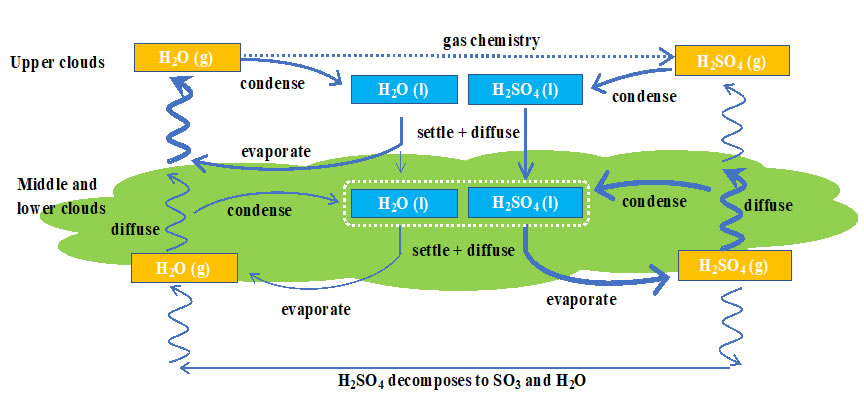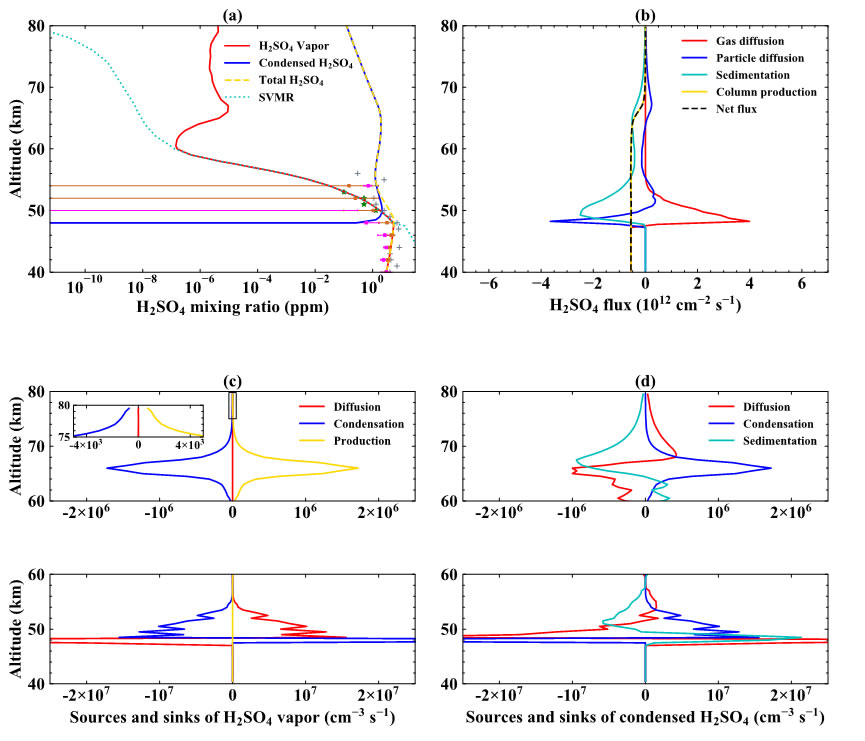A dynamical model for the formation and the cycles of the sulfuric acid cloud's binary-condensation system on Venus
Venus is globally covered by a thick layer of sulfuric acid clouds. According to early observations and simulations, these sulfuric acid clouds significantly regulate the climate on Venus by influencing the atmospheric radiative transfer, controlling the global circulation, and varying the transports of species in the atmosphere, etc. Thus, to get better understanding on the evolution and habitability of our twin sister Venus, it is essential to explore the formation of the sulfuric acid clouds, and the role of the clouds on radiation, dynamics, chemistry, and astrobiology in the Venusian climate.
However, the current measurements on Venus are greatly constrained by the globally covered thick clouds and the high surface temperature. Up to date, the dynamics and chemistry in the cloud formation are largely unknown. Most of previous Venusian cloud models assumed the vapors to reach the local thermodynamic equilibrium (LTE). But this assumption is questionable since it is not able to well reproduce the condensation process. Other models adopted more complicated microphysical approaches to explain the Venusian cloud mass loading and particle distributions. But the complicated microphysics largely reduced the efficiency of these simulations. Moreover, part of the models neglected the feedback of the cloud acidity on the vapor saturation vapor pressures, which was proposed to be significant. This attached large uncertainties to these simulations.
To solve this problem, a study was carried out by the research group of Prof. Cui. This study built a cloud model based on the 1D continuity equation for water and sulfuric acid in both gas and condensed phases, coupling simplified condensation of single-mode particles, the diffusion and chemistry of vapors, and the diffusion and sedimentation of cloud particles. The feedback of the cloud acidity on the vapor saturation pressures is included in this model, and the calculation efficiency is over 10 times faster than previous microphysical models. The simulated vapor distributions, cloud mass loading and acidity in this study are consistent with observations.

The cloud cycles are represented in Figure 1. This study proposed that sulfuric acid is mainly in the condensed phase in the Venusian cloud layers. Its evaporation-diffusion-condensation cycle in the lower clouds significantly increases the cloud mass loading in this layer. Water vapor mainly condenses in the upper clouds. The condensed water constantly evaporates from the falling droplets, controlled by the increasing temperature. This results in the increase of cloud acidity with the decreasing altitude. The simulated particle diameter agrees to the observed Mode-2 particles, indicating that the condensation of Mode-2 particles dominate the Venusian cloud formation.

Also, this study was the first to propose that the sulfuric acid in the upper clouds is highly supersaturated, shown in Figure 2. It was validated by the sensitivity tests and the comparison with previous microphysical models. The supersaturation of sulfuric acid is regulated by its chemical net production rate. The relatively low condensation efficiency in the upper clouds is not able to consume the quickly produced sulfuric acid vapor by chemical processes. Therefore, its vapor mixing ratio is about three orders of magnitude larger than its saturation value. This result disagrees to the LTE assumption on sulfuric acid in the upper clouds, and corroborates with the homogeneous-nucleation theory of sulfuric acid in this region.
The relevant research paper was published by the Journal of Geophysical Research-Planets on February 15, 2022. Both the first author and the corresponding author of this paper were Longkang Dai. This study was supervised by Prof. Zhang from University of California Santa Cruz (UCSC).
Paper link: https://doi.org/10.1029/2021JE007060.

